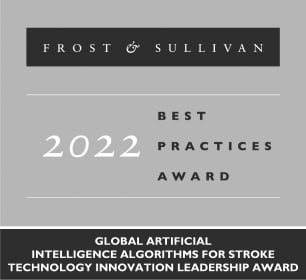[Insights in AI Virtual Series Webinar] Join us April 23 as Dr. Vishal Jani shares proven approaches to help improve outcomes for hemorrhagic stroke patients.
At RapidAI, we understand that technology is just one part of any successful patient outcome. From the person who picks up the phone to call 9-1-1, to the first responders, doctors and other healthcare professionals providing care, there are many heroes in each story. Here, we spotlight these incredible individuals who are saving and changing lives in our Rapid Hero Stories.
When an 87-year-old Wisconsin man arrived at a hospital with aphasia and weakness on his right side, he was lucky to have made it there. A veteran who lives alone, he was found on the living room floor of his apartment around 11 a.m. by the volunteer who brings his daily Meals on Wheels delivery. Realizing the man had a stroke, the volunteer called 911, but she had no idea how long he had been in that condition. No one did.
“He received his meals daily through Meals on Wheels, so we knew they had seen him the day before,” said Dr. Daniel Gibson, the neurointerventional surgeon who performed the patient’s thrombectomy. “The next day, 24 hours later, they came back and found him with complete paralysis of the right side, an inability to speak or communicate, and a lack of awareness of things on the right, which are classic symptoms of a severe stroke involving the left hemisphere. His NIH stroke scale score was 23, which was consistent with a major life-threatening stroke. With his clinical history of atrial fibrillation, our ED providers immediately suspected that he had a large vessel ischemic stroke.”
The triage protocol at the receiving hospital is to screen patients with a last known well of less than 24 hours or when symptom onset is unknown. The patient, falling within the latter category, was given multiple scans, including a CT perfusion scan. His Rapid CTP results were favorable, showing what Gibson termed “a potentially reversible stroke.” But how should the patient be treated?
Guidelines established in 2018 by the American Heart Association (AHA) recommend that endovascular treatment should not be pursued if more than 24 hours has elapsed since the patient’s last known normal. In this case, the patient was last seen in a normal state more than a day before arriving at the hospital. “According to the current AHA guidelines, this patient would not have met inclusion criteria in any published randomized clinical trials related to mechanical therapies for stroke,” Gibson said.
Despite the ambiguity of the patient’s last known well time, his Rapid® results were encouraging enough for transfer to the health system’s primary stroke center, where Gibson and the stroke team decided to move forward with a mechanical thrombectomy to remove the clot blocking blood flow to his brain.
“His perfusion imaging looked incredibly favorable, and I feel like we have a societal obligation on some level to treat these patients whenever possible,” Gibson explained. “My preference in these cases, when there is no clinical evidence with which to guide treatment, is to reach out to the patient’s family or surrogate decision-maker and explain all options. If that is not possible, the question becomes whether to rigidly adhere to current clinical guidelines—which we recognize are not always applicable to all patients—or apply the Golden Rule and treat others as you or your loved ones would want to be treated in a similar situation.
“In this case, while we didn’t know exactly when the patient’s symptoms started, there was a high probability the stroke was less than 24 hours old, and his perfusion imaging suggested that regardless of time, the physiology of the stroke was fundamentally reversible with restored blood flow. Philosophically, I recognize guidelines have immense value but inherently lag behind both technology and published clinical evidence. Currently, it’s the evolution in imaging technology like RapidAI and ever-improving medical devices for retrieving clots that are driving our willingness and proficiency to treat patients who historically have been left to die.”
The procedure was successful, and the patient has since made a complete recovery. Fortunately, he wasn’t treated strictly according to guidelines. He was treated according to the results of his perfusion scan by a doctor who looked at the human being on the table and the clinical evidence of his condition.
“The state of stroke in 2020 is that there is an ever-increasing population of patients in whom we know reperfusion therapies work. We need to continue to develop and fund randomized clinical trials so that we can expand our understanding of this disease and patient eligibility criteria. Historically we have excluded the disabled and socially isolated from past clinical trials of thrombectomy which has the effect of preventing the most vulnerable in our population from receiving care that we now know to be potentially lifesaving. With RapidAI, we are able to apply the same technology to these patients, receiving results in near real-time, and now providing the possibility of hope where once there was none.”
RapidAI gives stroke teams and their patients more of what they desperately need: time. By notifying the entire stroke care team—doctors, emergency personnel and logistics—at the earliest possible moment and giving them the patient images and information they need to make the best possible decisions, they can save lives.
Dr. Daniel Gibson’s first-grade daughter has gotten quite proficient at reading the mismatch maps the Rapid imaging platform sends her dad. If there’s a lot of green (representing salvageable brain tissue) and little red, she knows her dad is going to be hurrying to the hospital to make someone well again. And that idea makes her very happy.
Protocols are everything when a stroke patient is brought in. Those developed at the advanced primary stroke center (PSC) the patient was brought to are managed in part by Abby Kosmoski, neurointerventional surgery nurse practitioner. When the patient arrived at the receiving hospital, he was immediately assessed and given three scans: NCCT, CTA and CTP. Rapid results and source images were then delivered to stroke team members via PACS, email and the Rapid Mobile App. The patient was transferred to the PSC and taken into the interventional radiology (IR) suite where a mechanical thrombectomy was performed. The operation’s efficacy was graded. After the reperfusion was deemed successful, the patient was taken to the neuro intensive care unit for one-on-one nursing for 24 hours. “Lots of things have to happen in parallel, so the speed at which the doctors can get these images and make game-time decisions is remarkable,” Kosmoski said.


